Comprehensive Review of the Health and Social Care Act 2012
VerifiedAdded on 2023/06/08
|12
|4378
|215
Essay
AI Summary
This essay provides a detailed analysis of the Health and Social Care Act 2012, enacted in the United Kingdom. It begins with an introduction to public health policy and the act's objectives, emphasizing its role in empowering patients and improving healthcare services. The main body of the essay delves into the act's various parts, including provisions for health services in England, public health regulations, adult health and care services, and the involvement of the public and local government. It examines the establishment of clinical commissioning groups, the regulation of healthcare workers, and the role of the National Institute for Health and Care Excellence. Furthermore, the essay discusses the act's impact on information standards, the restructuring of health authorities, and the abolishment of certain public bodies. The analysis covers the act's implications for the National Health Service (NHS), social care, and patient involvement, highlighting the changes and improvements introduced to enhance the quality and efficiency of healthcare services. The essay concludes by summarizing the key points and the overall significance of the Health and Social Care Act 2012 in shaping the landscape of public health in the UK.
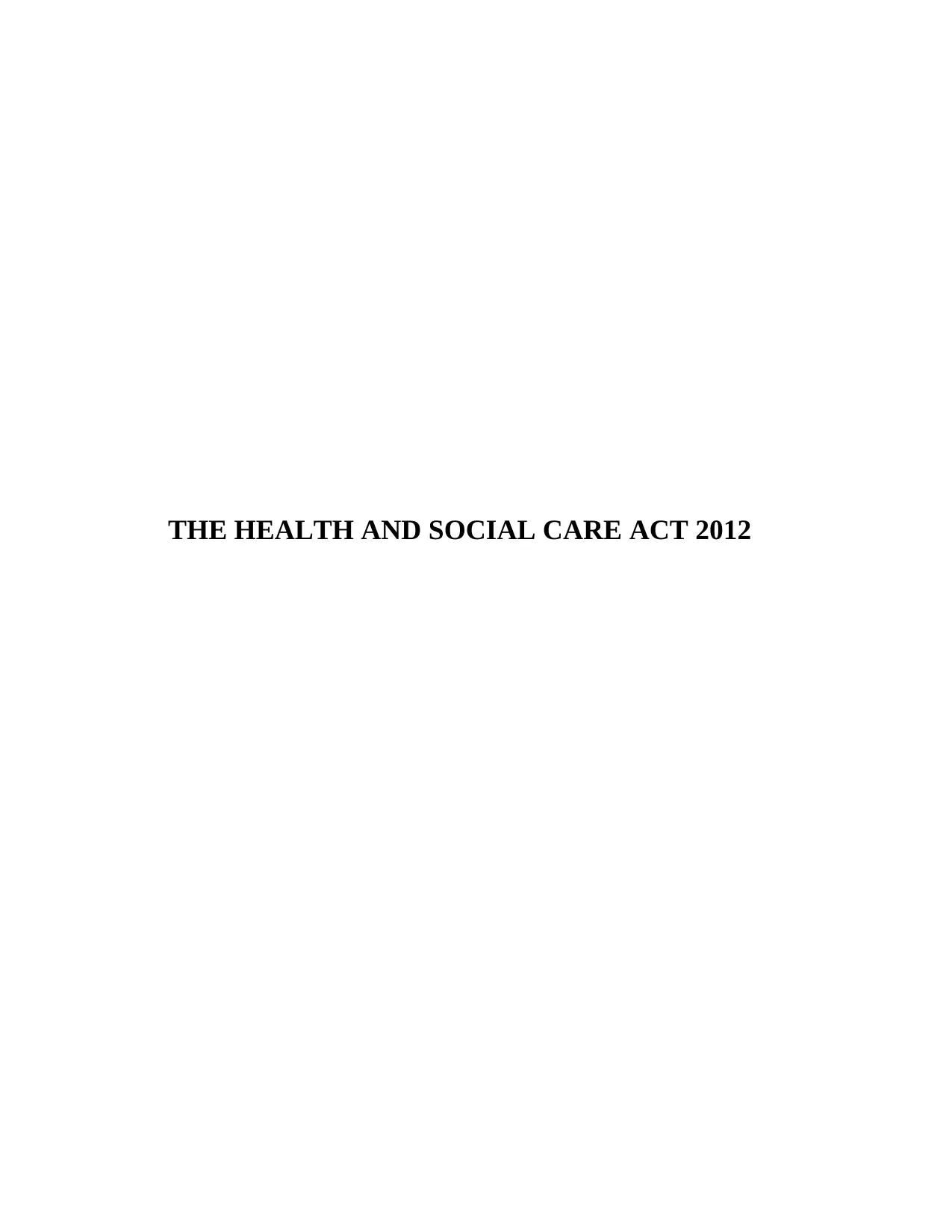
THE HEALTH AND SOCIAL CARE ACT 2012
Paraphrase This Document
Need a fresh take? Get an instant paraphrase of this document with our AI Paraphraser
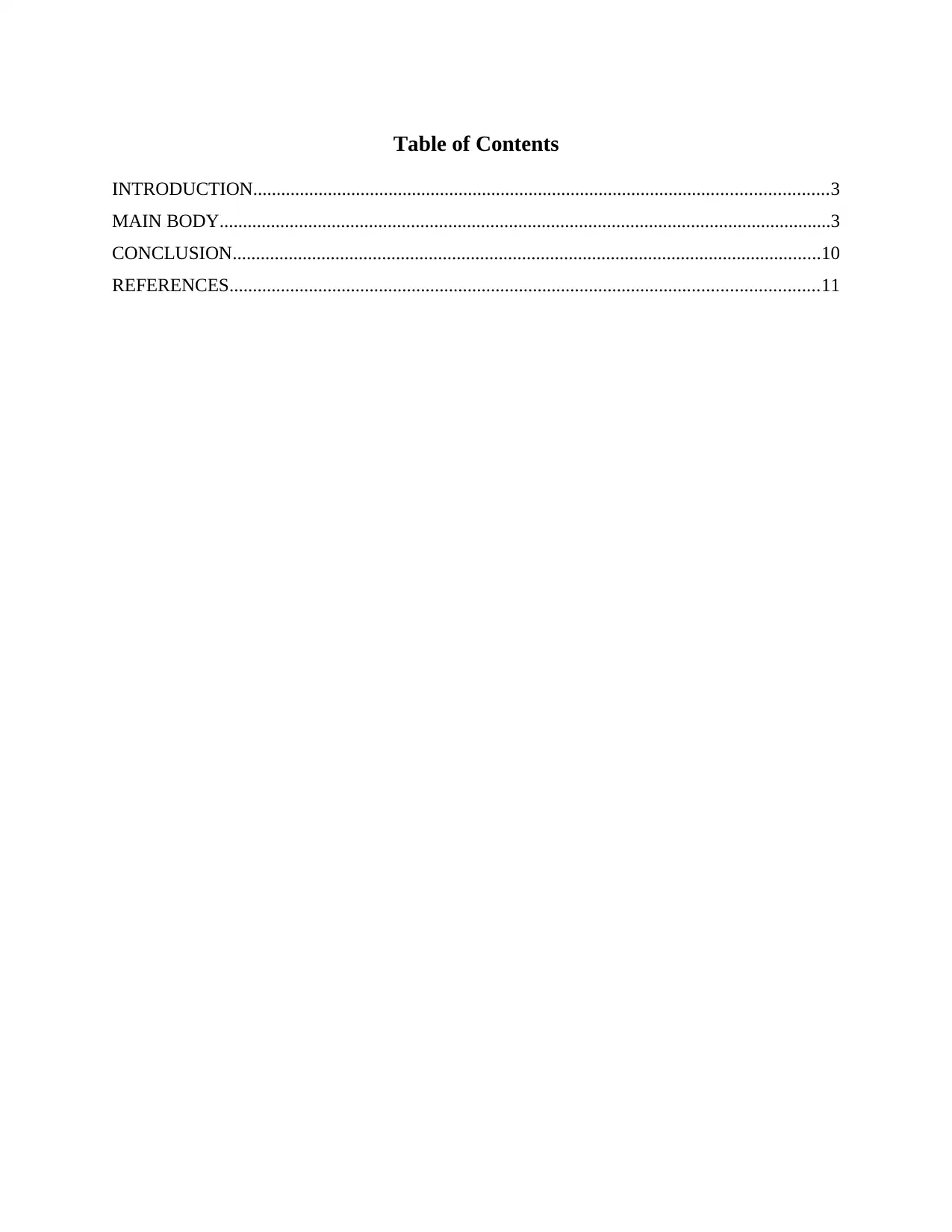
Table of Contents
INTRODUCTION...........................................................................................................................3
MAIN BODY...................................................................................................................................3
CONCLUSION..............................................................................................................................10
REFERENCES..............................................................................................................................11
INTRODUCTION...........................................................................................................................3
MAIN BODY...................................................................................................................................3
CONCLUSION..............................................................................................................................10
REFERENCES..............................................................................................................................11
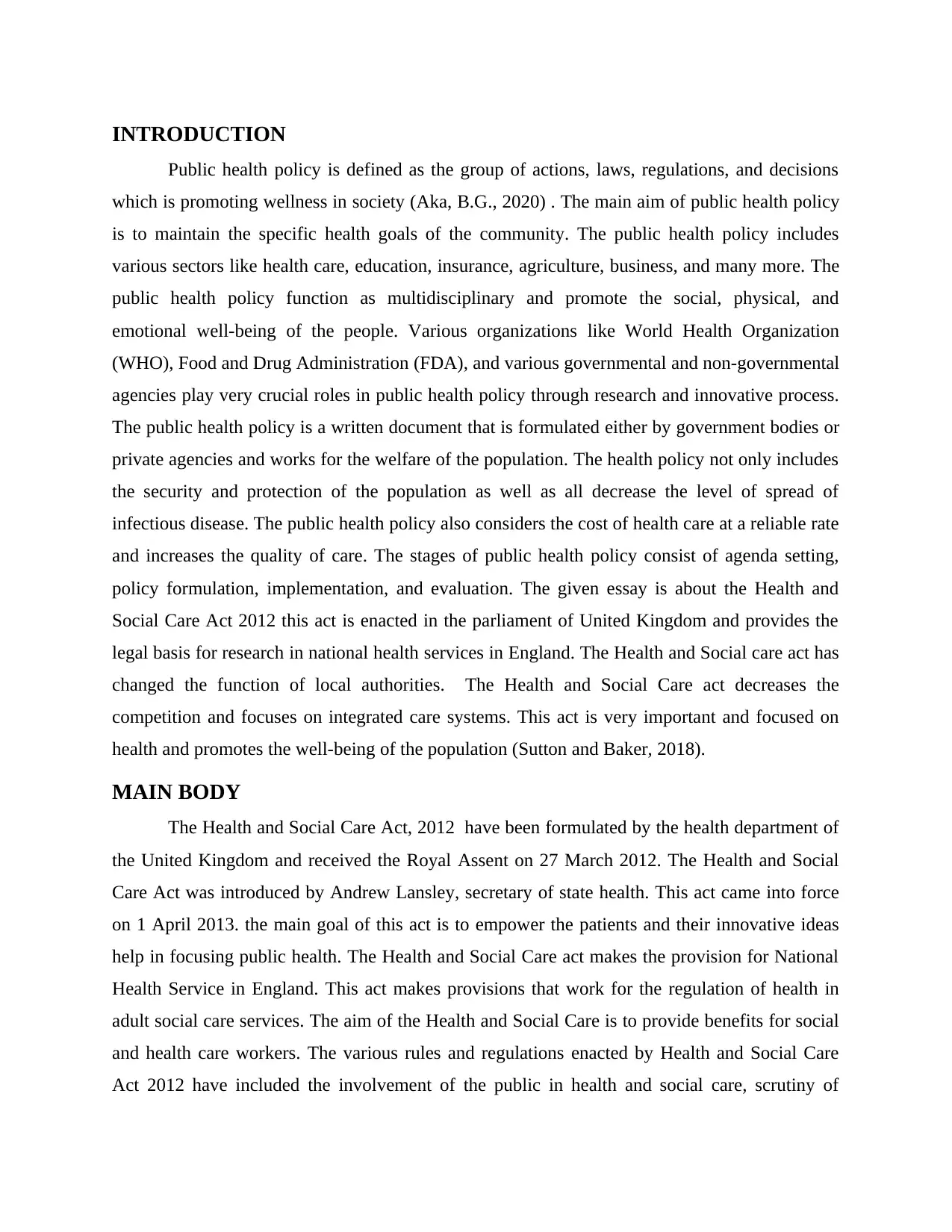
INTRODUCTION
Public health policy is defined as the group of actions, laws, regulations, and decisions
which is promoting wellness in society (Aka, B.G., 2020) . The main aim of public health policy
is to maintain the specific health goals of the community. The public health policy includes
various sectors like health care, education, insurance, agriculture, business, and many more. The
public health policy function as multidisciplinary and promote the social, physical, and
emotional well-being of the people. Various organizations like World Health Organization
(WHO), Food and Drug Administration (FDA), and various governmental and non-governmental
agencies play very crucial roles in public health policy through research and innovative process.
The public health policy is a written document that is formulated either by government bodies or
private agencies and works for the welfare of the population. The health policy not only includes
the security and protection of the population as well as all decrease the level of spread of
infectious disease. The public health policy also considers the cost of health care at a reliable rate
and increases the quality of care. The stages of public health policy consist of agenda setting,
policy formulation, implementation, and evaluation. The given essay is about the Health and
Social Care Act 2012 this act is enacted in the parliament of United Kingdom and provides the
legal basis for research in national health services in England. The Health and Social care act has
changed the function of local authorities. The Health and Social Care act decreases the
competition and focuses on integrated care systems. This act is very important and focused on
health and promotes the well-being of the population (Sutton and Baker, 2018).
MAIN BODY
The Health and Social Care Act, 2012 have been formulated by the health department of
the United Kingdom and received the Royal Assent on 27 March 2012. The Health and Social
Care Act was introduced by Andrew Lansley, secretary of state health. This act came into force
on 1 April 2013. the main goal of this act is to empower the patients and their innovative ideas
help in focusing public health. The Health and Social Care act makes the provision for National
Health Service in England. This act makes provisions that work for the regulation of health in
adult social care services. The aim of the Health and Social Care is to provide benefits for social
and health care workers. The various rules and regulations enacted by Health and Social Care
Act 2012 have included the involvement of the public in health and social care, scrutiny of
Public health policy is defined as the group of actions, laws, regulations, and decisions
which is promoting wellness in society (Aka, B.G., 2020) . The main aim of public health policy
is to maintain the specific health goals of the community. The public health policy includes
various sectors like health care, education, insurance, agriculture, business, and many more. The
public health policy function as multidisciplinary and promote the social, physical, and
emotional well-being of the people. Various organizations like World Health Organization
(WHO), Food and Drug Administration (FDA), and various governmental and non-governmental
agencies play very crucial roles in public health policy through research and innovative process.
The public health policy is a written document that is formulated either by government bodies or
private agencies and works for the welfare of the population. The health policy not only includes
the security and protection of the population as well as all decrease the level of spread of
infectious disease. The public health policy also considers the cost of health care at a reliable rate
and increases the quality of care. The stages of public health policy consist of agenda setting,
policy formulation, implementation, and evaluation. The given essay is about the Health and
Social Care Act 2012 this act is enacted in the parliament of United Kingdom and provides the
legal basis for research in national health services in England. The Health and Social care act has
changed the function of local authorities. The Health and Social Care act decreases the
competition and focuses on integrated care systems. This act is very important and focused on
health and promotes the well-being of the population (Sutton and Baker, 2018).
MAIN BODY
The Health and Social Care Act, 2012 have been formulated by the health department of
the United Kingdom and received the Royal Assent on 27 March 2012. The Health and Social
Care Act was introduced by Andrew Lansley, secretary of state health. This act came into force
on 1 April 2013. the main goal of this act is to empower the patients and their innovative ideas
help in focusing public health. The Health and Social Care act makes the provision for National
Health Service in England. This act makes provisions that work for the regulation of health in
adult social care services. The aim of the Health and Social Care is to provide benefits for social
and health care workers. The various rules and regulations enacted by Health and Social Care
Act 2012 have included the involvement of the public in health and social care, scrutiny of
⊘ This is a preview!⊘
Do you want full access?
Subscribe today to unlock all pages.

Trusted by 1+ million students worldwide
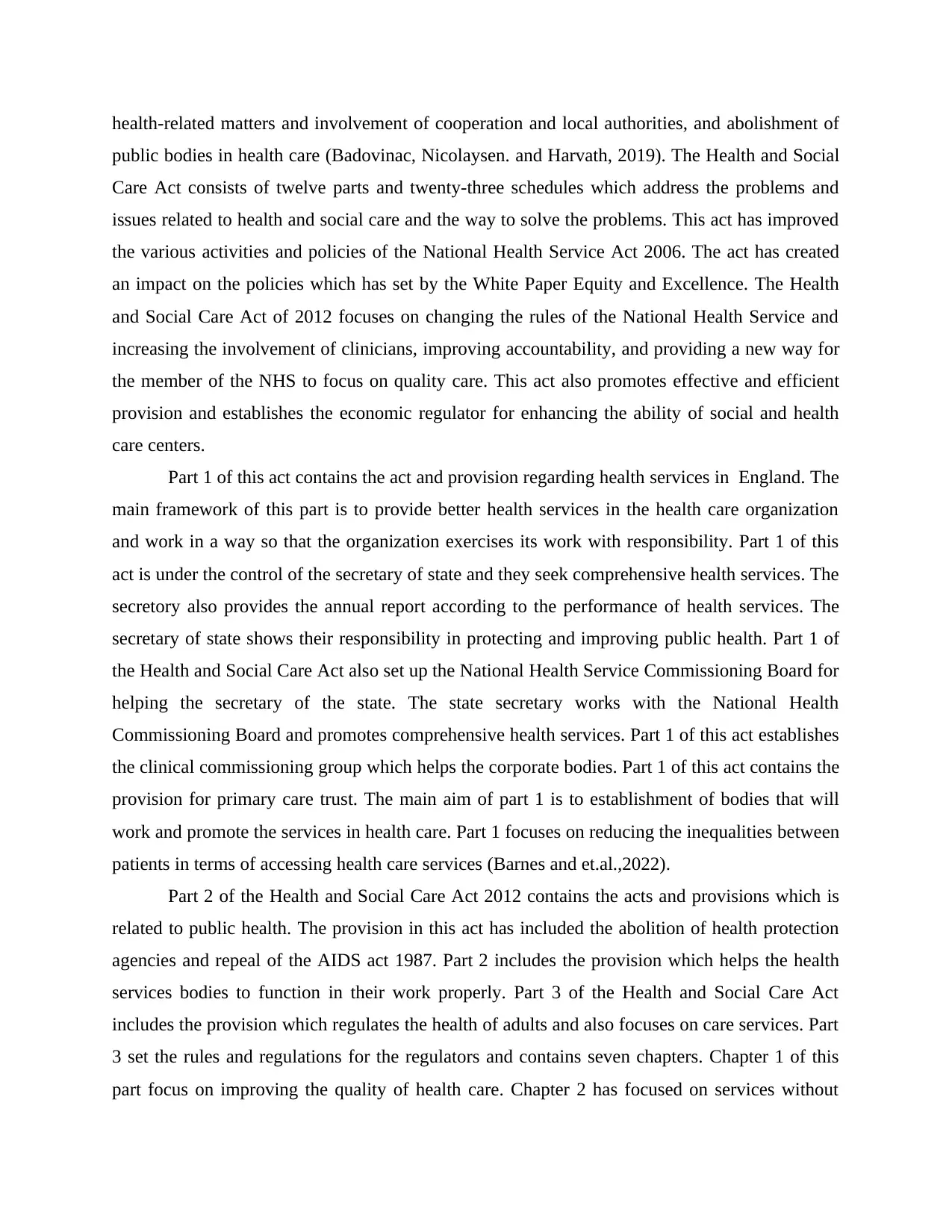
health-related matters and involvement of cooperation and local authorities, and abolishment of
public bodies in health care (Badovinac, Nicolaysen. and Harvath, 2019). The Health and Social
Care Act consists of twelve parts and twenty-three schedules which address the problems and
issues related to health and social care and the way to solve the problems. This act has improved
the various activities and policies of the National Health Service Act 2006. The act has created
an impact on the policies which has set by the White Paper Equity and Excellence. The Health
and Social Care Act of 2012 focuses on changing the rules of the National Health Service and
increasing the involvement of clinicians, improving accountability, and providing a new way for
the member of the NHS to focus on quality care. This act also promotes effective and efficient
provision and establishes the economic regulator for enhancing the ability of social and health
care centers.
Part 1 of this act contains the act and provision regarding health services in England. The
main framework of this part is to provide better health services in the health care organization
and work in a way so that the organization exercises its work with responsibility. Part 1 of this
act is under the control of the secretary of state and they seek comprehensive health services. The
secretory also provides the annual report according to the performance of health services. The
secretary of state shows their responsibility in protecting and improving public health. Part 1 of
the Health and Social Care Act also set up the National Health Service Commissioning Board for
helping the secretary of the state. The state secretary works with the National Health
Commissioning Board and promotes comprehensive health services. Part 1 of this act establishes
the clinical commissioning group which helps the corporate bodies. Part 1 of this act contains the
provision for primary care trust. The main aim of part 1 is to establishment of bodies that will
work and promote the services in health care. Part 1 focuses on reducing the inequalities between
patients in terms of accessing health care services (Barnes and et.al.,2022).
Part 2 of the Health and Social Care Act 2012 contains the acts and provisions which is
related to public health. The provision in this act has included the abolition of health protection
agencies and repeal of the AIDS act 1987. Part 2 includes the provision which helps the health
services bodies to function in their work properly. Part 3 of the Health and Social Care Act
includes the provision which regulates the health of adults and also focuses on care services. Part
3 set the rules and regulations for the regulators and contains seven chapters. Chapter 1 of this
part focus on improving the quality of health care. Chapter 2 has focused on services without
public bodies in health care (Badovinac, Nicolaysen. and Harvath, 2019). The Health and Social
Care Act consists of twelve parts and twenty-three schedules which address the problems and
issues related to health and social care and the way to solve the problems. This act has improved
the various activities and policies of the National Health Service Act 2006. The act has created
an impact on the policies which has set by the White Paper Equity and Excellence. The Health
and Social Care Act of 2012 focuses on changing the rules of the National Health Service and
increasing the involvement of clinicians, improving accountability, and providing a new way for
the member of the NHS to focus on quality care. This act also promotes effective and efficient
provision and establishes the economic regulator for enhancing the ability of social and health
care centers.
Part 1 of this act contains the act and provision regarding health services in England. The
main framework of this part is to provide better health services in the health care organization
and work in a way so that the organization exercises its work with responsibility. Part 1 of this
act is under the control of the secretary of state and they seek comprehensive health services. The
secretory also provides the annual report according to the performance of health services. The
secretary of state shows their responsibility in protecting and improving public health. Part 1 of
the Health and Social Care Act also set up the National Health Service Commissioning Board for
helping the secretary of the state. The state secretary works with the National Health
Commissioning Board and promotes comprehensive health services. Part 1 of this act establishes
the clinical commissioning group which helps the corporate bodies. Part 1 of this act contains the
provision for primary care trust. The main aim of part 1 is to establishment of bodies that will
work and promote the services in health care. Part 1 focuses on reducing the inequalities between
patients in terms of accessing health care services (Barnes and et.al.,2022).
Part 2 of the Health and Social Care Act 2012 contains the acts and provisions which is
related to public health. The provision in this act has included the abolition of health protection
agencies and repeal of the AIDS act 1987. Part 2 includes the provision which helps the health
services bodies to function in their work properly. Part 3 of the Health and Social Care Act
includes the provision which regulates the health of adults and also focuses on care services. Part
3 set the rules and regulations for the regulators and contains seven chapters. Chapter 1 of this
part focus on improving the quality of health care. Chapter 2 has focused on services without
Paraphrase This Document
Need a fresh take? Get an instant paraphrase of this document with our AI Paraphraser
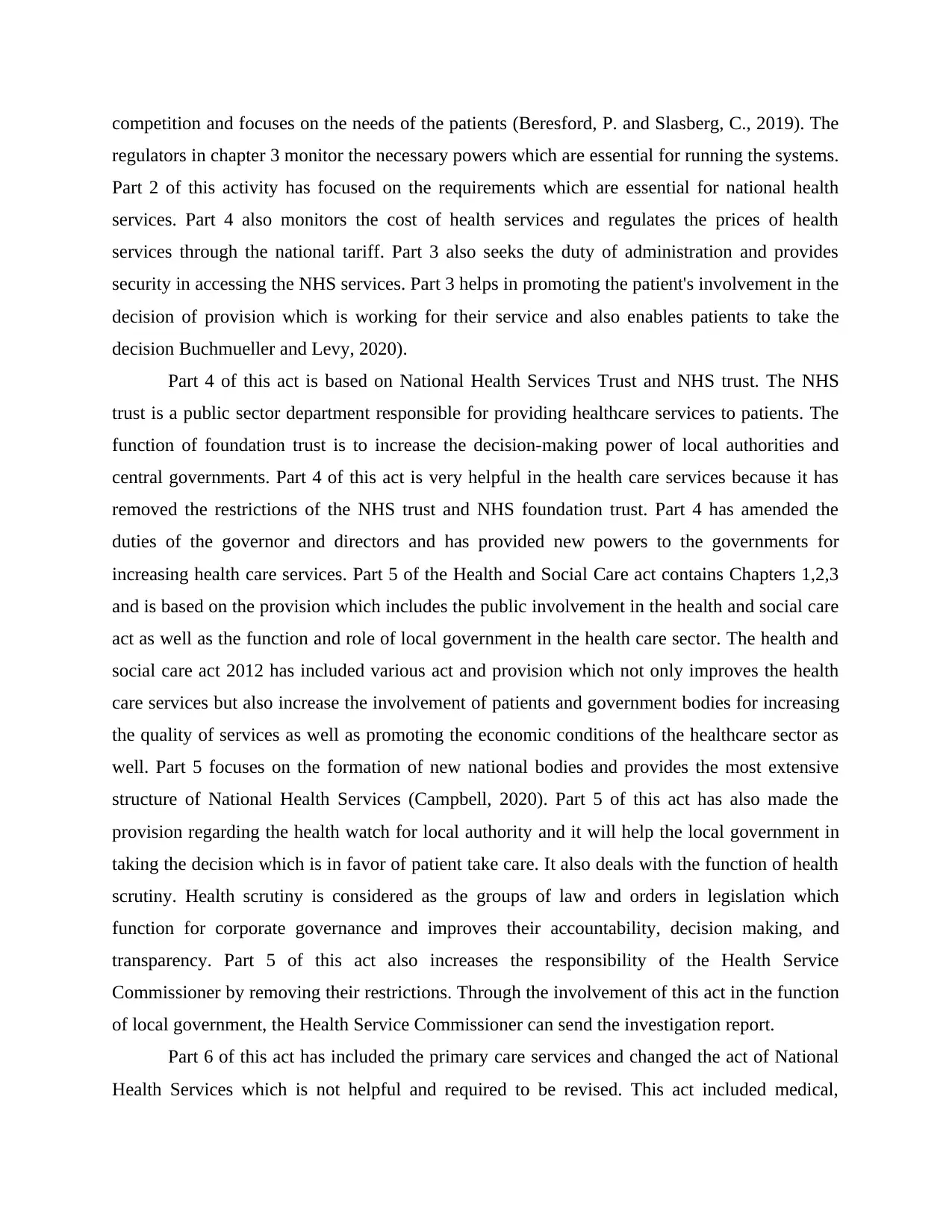
competition and focuses on the needs of the patients (Beresford, P. and Slasberg, C., 2019). The
regulators in chapter 3 monitor the necessary powers which are essential for running the systems.
Part 2 of this activity has focused on the requirements which are essential for national health
services. Part 4 also monitors the cost of health services and regulates the prices of health
services through the national tariff. Part 3 also seeks the duty of administration and provides
security in accessing the NHS services. Part 3 helps in promoting the patient's involvement in the
decision of provision which is working for their service and also enables patients to take the
decision Buchmueller and Levy, 2020).
Part 4 of this act is based on National Health Services Trust and NHS trust. The NHS
trust is a public sector department responsible for providing healthcare services to patients. The
function of foundation trust is to increase the decision-making power of local authorities and
central governments. Part 4 of this act is very helpful in the health care services because it has
removed the restrictions of the NHS trust and NHS foundation trust. Part 4 has amended the
duties of the governor and directors and has provided new powers to the governments for
increasing health care services. Part 5 of the Health and Social Care act contains Chapters 1,2,3
and is based on the provision which includes the public involvement in the health and social care
act as well as the function and role of local government in the health care sector. The health and
social care act 2012 has included various act and provision which not only improves the health
care services but also increase the involvement of patients and government bodies for increasing
the quality of services as well as promoting the economic conditions of the healthcare sector as
well. Part 5 focuses on the formation of new national bodies and provides the most extensive
structure of National Health Services (Campbell, 2020). Part 5 of this act has also made the
provision regarding the health watch for local authority and it will help the local government in
taking the decision which is in favor of patient take care. It also deals with the function of health
scrutiny. Health scrutiny is considered as the groups of law and orders in legislation which
function for corporate governance and improves their accountability, decision making, and
transparency. Part 5 of this act also increases the responsibility of the Health Service
Commissioner by removing their restrictions. Through the involvement of this act in the function
of local government, the Health Service Commissioner can send the investigation report.
Part 6 of this act has included the primary care services and changed the act of National
Health Services which is not helpful and required to be revised. This act included medical,
regulators in chapter 3 monitor the necessary powers which are essential for running the systems.
Part 2 of this activity has focused on the requirements which are essential for national health
services. Part 4 also monitors the cost of health services and regulates the prices of health
services through the national tariff. Part 3 also seeks the duty of administration and provides
security in accessing the NHS services. Part 3 helps in promoting the patient's involvement in the
decision of provision which is working for their service and also enables patients to take the
decision Buchmueller and Levy, 2020).
Part 4 of this act is based on National Health Services Trust and NHS trust. The NHS
trust is a public sector department responsible for providing healthcare services to patients. The
function of foundation trust is to increase the decision-making power of local authorities and
central governments. Part 4 of this act is very helpful in the health care services because it has
removed the restrictions of the NHS trust and NHS foundation trust. Part 4 has amended the
duties of the governor and directors and has provided new powers to the governments for
increasing health care services. Part 5 of the Health and Social Care act contains Chapters 1,2,3
and is based on the provision which includes the public involvement in the health and social care
act as well as the function and role of local government in the health care sector. The health and
social care act 2012 has included various act and provision which not only improves the health
care services but also increase the involvement of patients and government bodies for increasing
the quality of services as well as promoting the economic conditions of the healthcare sector as
well. Part 5 focuses on the formation of new national bodies and provides the most extensive
structure of National Health Services (Campbell, 2020). Part 5 of this act has also made the
provision regarding the health watch for local authority and it will help the local government in
taking the decision which is in favor of patient take care. It also deals with the function of health
scrutiny. Health scrutiny is considered as the groups of law and orders in legislation which
function for corporate governance and improves their accountability, decision making, and
transparency. Part 5 of this act also increases the responsibility of the Health Service
Commissioner by removing their restrictions. Through the involvement of this act in the function
of local government, the Health Service Commissioner can send the investigation report.
Part 6 of this act has included the primary care services and changed the act of National
Health Services which is not helpful and required to be revised. This act included medical,
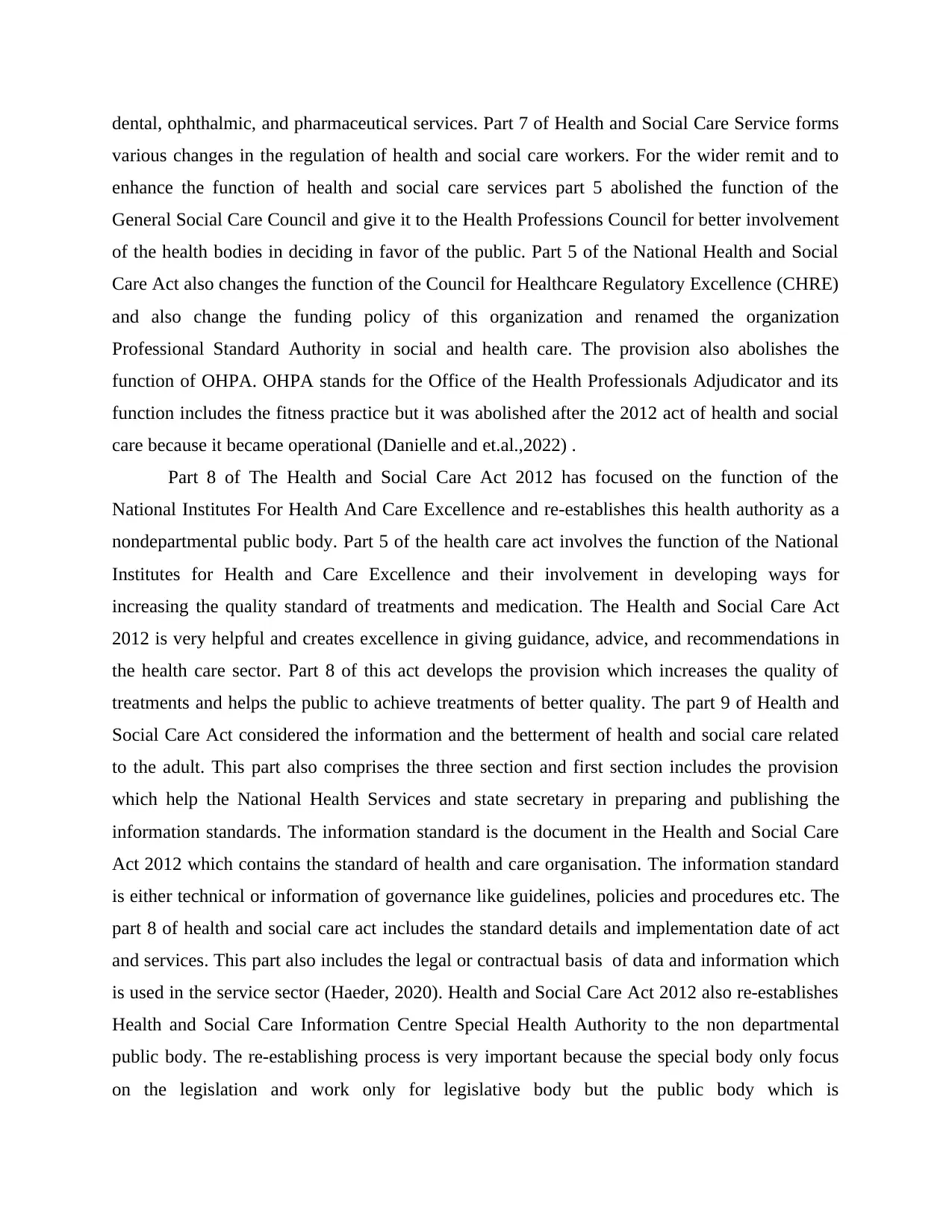
dental, ophthalmic, and pharmaceutical services. Part 7 of Health and Social Care Service forms
various changes in the regulation of health and social care workers. For the wider remit and to
enhance the function of health and social care services part 5 abolished the function of the
General Social Care Council and give it to the Health Professions Council for better involvement
of the health bodies in deciding in favor of the public. Part 5 of the National Health and Social
Care Act also changes the function of the Council for Healthcare Regulatory Excellence (CHRE)
and also change the funding policy of this organization and renamed the organization
Professional Standard Authority in social and health care. The provision also abolishes the
function of OHPA. OHPA stands for the Office of the Health Professionals Adjudicator and its
function includes the fitness practice but it was abolished after the 2012 act of health and social
care because it became operational (Danielle and et.al.,2022) .
Part 8 of The Health and Social Care Act 2012 has focused on the function of the
National Institutes For Health And Care Excellence and re-establishes this health authority as a
nondepartmental public body. Part 5 of the health care act involves the function of the National
Institutes for Health and Care Excellence and their involvement in developing ways for
increasing the quality standard of treatments and medication. The Health and Social Care Act
2012 is very helpful and creates excellence in giving guidance, advice, and recommendations in
the health care sector. Part 8 of this act develops the provision which increases the quality of
treatments and helps the public to achieve treatments of better quality. The part 9 of Health and
Social Care Act considered the information and the betterment of health and social care related
to the adult. This part also comprises the three section and first section includes the provision
which help the National Health Services and state secretary in preparing and publishing the
information standards. The information standard is the document in the Health and Social Care
Act 2012 which contains the standard of health and care organisation. The information standard
is either technical or information of governance like guidelines, policies and procedures etc. The
part 8 of health and social care act includes the standard details and implementation date of act
and services. This part also includes the legal or contractual basis of data and information which
is used in the service sector (Haeder, 2020). Health and Social Care Act 2012 also re-establishes
Health and Social Care Information Centre Special Health Authority to the non departmental
public body. The re-establishing process is very important because the special body only focus
on the legislation and work only for legislative body but the public body which is
various changes in the regulation of health and social care workers. For the wider remit and to
enhance the function of health and social care services part 5 abolished the function of the
General Social Care Council and give it to the Health Professions Council for better involvement
of the health bodies in deciding in favor of the public. Part 5 of the National Health and Social
Care Act also changes the function of the Council for Healthcare Regulatory Excellence (CHRE)
and also change the funding policy of this organization and renamed the organization
Professional Standard Authority in social and health care. The provision also abolishes the
function of OHPA. OHPA stands for the Office of the Health Professionals Adjudicator and its
function includes the fitness practice but it was abolished after the 2012 act of health and social
care because it became operational (Danielle and et.al.,2022) .
Part 8 of The Health and Social Care Act 2012 has focused on the function of the
National Institutes For Health And Care Excellence and re-establishes this health authority as a
nondepartmental public body. Part 5 of the health care act involves the function of the National
Institutes for Health and Care Excellence and their involvement in developing ways for
increasing the quality standard of treatments and medication. The Health and Social Care Act
2012 is very helpful and creates excellence in giving guidance, advice, and recommendations in
the health care sector. Part 8 of this act develops the provision which increases the quality of
treatments and helps the public to achieve treatments of better quality. The part 9 of Health and
Social Care Act considered the information and the betterment of health and social care related
to the adult. This part also comprises the three section and first section includes the provision
which help the National Health Services and state secretary in preparing and publishing the
information standards. The information standard is the document in the Health and Social Care
Act 2012 which contains the standard of health and care organisation. The information standard
is either technical or information of governance like guidelines, policies and procedures etc. The
part 8 of health and social care act includes the standard details and implementation date of act
and services. This part also includes the legal or contractual basis of data and information which
is used in the service sector (Haeder, 2020). Health and Social Care Act 2012 also re-establishes
Health and Social Care Information Centre Special Health Authority to the non departmental
public body. The re-establishing process is very important because the special body only focus
on the legislation and work only for legislative body but the public body which is
⊘ This is a preview!⊘
Do you want full access?
Subscribe today to unlock all pages.

Trusted by 1+ million students worldwide
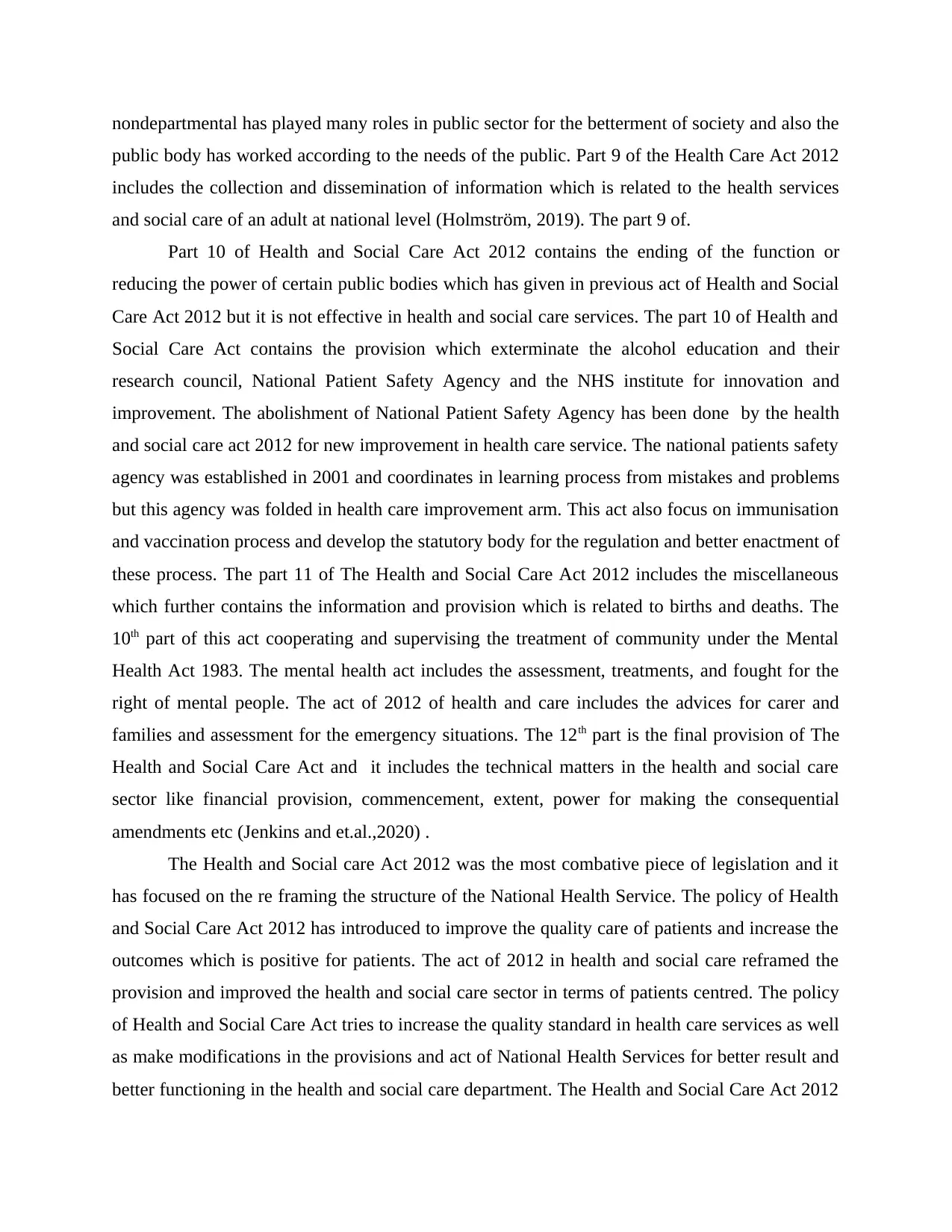
nondepartmental has played many roles in public sector for the betterment of society and also the
public body has worked according to the needs of the public. Part 9 of the Health Care Act 2012
includes the collection and dissemination of information which is related to the health services
and social care of an adult at national level (Holmström, 2019). The part 9 of.
Part 10 of Health and Social Care Act 2012 contains the ending of the function or
reducing the power of certain public bodies which has given in previous act of Health and Social
Care Act 2012 but it is not effective in health and social care services. The part 10 of Health and
Social Care Act contains the provision which exterminate the alcohol education and their
research council, National Patient Safety Agency and the NHS institute for innovation and
improvement. The abolishment of National Patient Safety Agency has been done by the health
and social care act 2012 for new improvement in health care service. The national patients safety
agency was established in 2001 and coordinates in learning process from mistakes and problems
but this agency was folded in health care improvement arm. This act also focus on immunisation
and vaccination process and develop the statutory body for the regulation and better enactment of
these process. The part 11 of The Health and Social Care Act 2012 includes the miscellaneous
which further contains the information and provision which is related to births and deaths. The
10th part of this act cooperating and supervising the treatment of community under the Mental
Health Act 1983. The mental health act includes the assessment, treatments, and fought for the
right of mental people. The act of 2012 of health and care includes the advices for carer and
families and assessment for the emergency situations. The 12th part is the final provision of The
Health and Social Care Act and it includes the technical matters in the health and social care
sector like financial provision, commencement, extent, power for making the consequential
amendments etc (Jenkins and et.al.,2020) .
The Health and Social care Act 2012 was the most combative piece of legislation and it
has focused on the re framing the structure of the National Health Service. The policy of Health
and Social Care Act 2012 has introduced to improve the quality care of patients and increase the
outcomes which is positive for patients. The act of 2012 in health and social care reframed the
provision and improved the health and social care sector in terms of patients centred. The policy
of Health and Social Care Act tries to increase the quality standard in health care services as well
as make modifications in the provisions and act of National Health Services for better result and
better functioning in the health and social care department. The Health and Social Care Act 2012
public body has worked according to the needs of the public. Part 9 of the Health Care Act 2012
includes the collection and dissemination of information which is related to the health services
and social care of an adult at national level (Holmström, 2019). The part 9 of.
Part 10 of Health and Social Care Act 2012 contains the ending of the function or
reducing the power of certain public bodies which has given in previous act of Health and Social
Care Act 2012 but it is not effective in health and social care services. The part 10 of Health and
Social Care Act contains the provision which exterminate the alcohol education and their
research council, National Patient Safety Agency and the NHS institute for innovation and
improvement. The abolishment of National Patient Safety Agency has been done by the health
and social care act 2012 for new improvement in health care service. The national patients safety
agency was established in 2001 and coordinates in learning process from mistakes and problems
but this agency was folded in health care improvement arm. This act also focus on immunisation
and vaccination process and develop the statutory body for the regulation and better enactment of
these process. The part 11 of The Health and Social Care Act 2012 includes the miscellaneous
which further contains the information and provision which is related to births and deaths. The
10th part of this act cooperating and supervising the treatment of community under the Mental
Health Act 1983. The mental health act includes the assessment, treatments, and fought for the
right of mental people. The act of 2012 of health and care includes the advices for carer and
families and assessment for the emergency situations. The 12th part is the final provision of The
Health and Social Care Act and it includes the technical matters in the health and social care
sector like financial provision, commencement, extent, power for making the consequential
amendments etc (Jenkins and et.al.,2020) .
The Health and Social care Act 2012 was the most combative piece of legislation and it
has focused on the re framing the structure of the National Health Service. The policy of Health
and Social Care Act 2012 has introduced to improve the quality care of patients and increase the
outcomes which is positive for patients. The act of 2012 in health and social care reframed the
provision and improved the health and social care sector in terms of patients centred. The policy
of Health and Social Care Act tries to increase the quality standard in health care services as well
as make modifications in the provisions and act of National Health Services for better result and
better functioning in the health and social care department. The Health and Social Care Act 2012
Paraphrase This Document
Need a fresh take? Get an instant paraphrase of this document with our AI Paraphraser
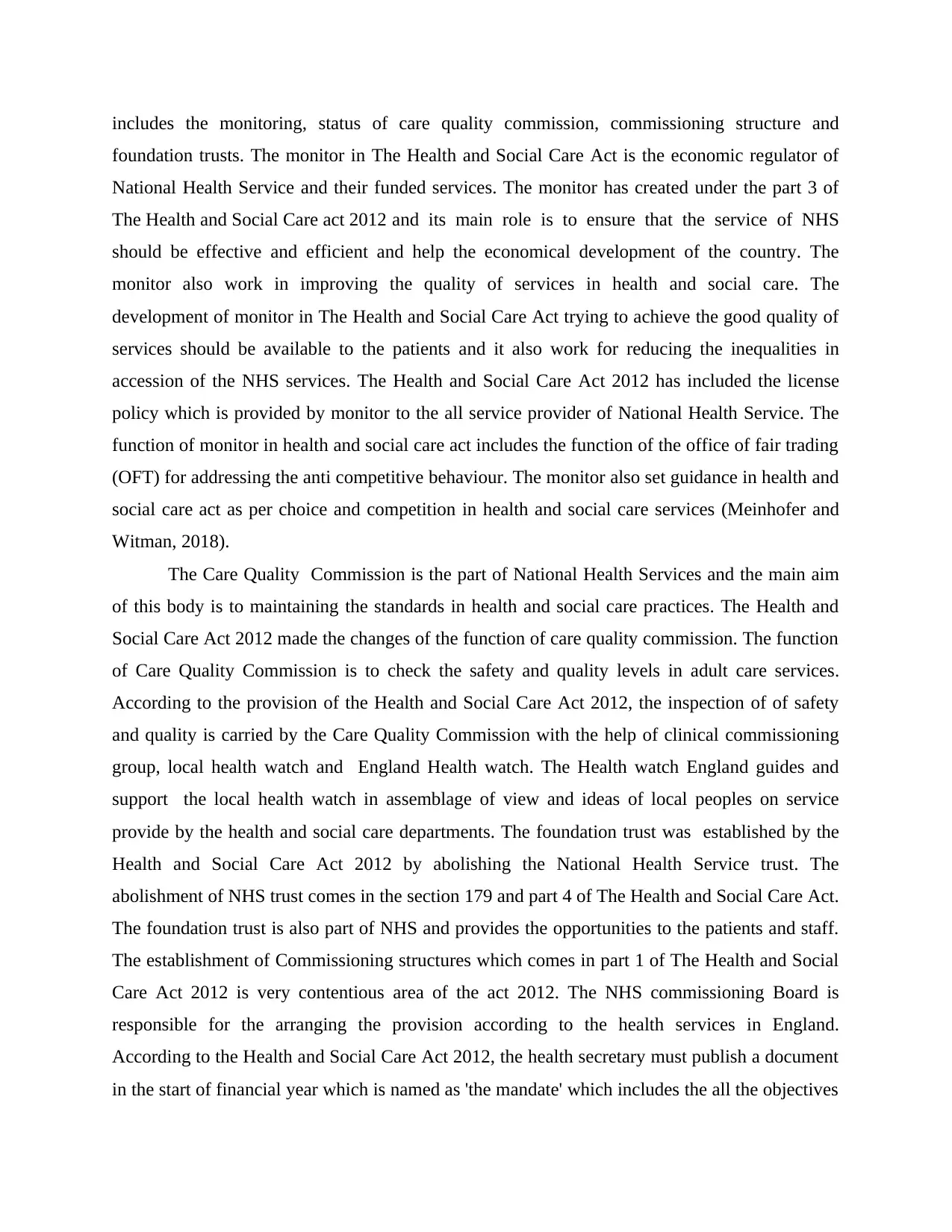
includes the monitoring, status of care quality commission, commissioning structure and
foundation trusts. The monitor in The Health and Social Care Act is the economic regulator of
National Health Service and their funded services. The monitor has created under the part 3 of
The Health and Social Care act 2012 and its main role is to ensure that the service of NHS
should be effective and efficient and help the economical development of the country. The
monitor also work in improving the quality of services in health and social care. The
development of monitor in The Health and Social Care Act trying to achieve the good quality of
services should be available to the patients and it also work for reducing the inequalities in
accession of the NHS services. The Health and Social Care Act 2012 has included the license
policy which is provided by monitor to the all service provider of National Health Service. The
function of monitor in health and social care act includes the function of the office of fair trading
(OFT) for addressing the anti competitive behaviour. The monitor also set guidance in health and
social care act as per choice and competition in health and social care services (Meinhofer and
Witman, 2018).
The Care Quality Commission is the part of National Health Services and the main aim
of this body is to maintaining the standards in health and social care practices. The Health and
Social Care Act 2012 made the changes of the function of care quality commission. The function
of Care Quality Commission is to check the safety and quality levels in adult care services.
According to the provision of the Health and Social Care Act 2012, the inspection of of safety
and quality is carried by the Care Quality Commission with the help of clinical commissioning
group, local health watch and England Health watch. The Health watch England guides and
support the local health watch in assemblage of view and ideas of local peoples on service
provide by the health and social care departments. The foundation trust was established by the
Health and Social Care Act 2012 by abolishing the National Health Service trust. The
abolishment of NHS trust comes in the section 179 and part 4 of The Health and Social Care Act.
The foundation trust is also part of NHS and provides the opportunities to the patients and staff.
The establishment of Commissioning structures which comes in part 1 of The Health and Social
Care Act 2012 is very contentious area of the act 2012. The NHS commissioning Board is
responsible for the arranging the provision according to the health services in England.
According to the Health and Social Care Act 2012, the health secretary must publish a document
in the start of financial year which is named as 'the mandate' which includes the all the objectives
foundation trusts. The monitor in The Health and Social Care Act is the economic regulator of
National Health Service and their funded services. The monitor has created under the part 3 of
The Health and Social Care act 2012 and its main role is to ensure that the service of NHS
should be effective and efficient and help the economical development of the country. The
monitor also work in improving the quality of services in health and social care. The
development of monitor in The Health and Social Care Act trying to achieve the good quality of
services should be available to the patients and it also work for reducing the inequalities in
accession of the NHS services. The Health and Social Care Act 2012 has included the license
policy which is provided by monitor to the all service provider of National Health Service. The
function of monitor in health and social care act includes the function of the office of fair trading
(OFT) for addressing the anti competitive behaviour. The monitor also set guidance in health and
social care act as per choice and competition in health and social care services (Meinhofer and
Witman, 2018).
The Care Quality Commission is the part of National Health Services and the main aim
of this body is to maintaining the standards in health and social care practices. The Health and
Social Care Act 2012 made the changes of the function of care quality commission. The function
of Care Quality Commission is to check the safety and quality levels in adult care services.
According to the provision of the Health and Social Care Act 2012, the inspection of of safety
and quality is carried by the Care Quality Commission with the help of clinical commissioning
group, local health watch and England Health watch. The Health watch England guides and
support the local health watch in assemblage of view and ideas of local peoples on service
provide by the health and social care departments. The foundation trust was established by the
Health and Social Care Act 2012 by abolishing the National Health Service trust. The
abolishment of NHS trust comes in the section 179 and part 4 of The Health and Social Care Act.
The foundation trust is also part of NHS and provides the opportunities to the patients and staff.
The establishment of Commissioning structures which comes in part 1 of The Health and Social
Care Act 2012 is very contentious area of the act 2012. The NHS commissioning Board is
responsible for the arranging the provision according to the health services in England.
According to the Health and Social Care Act 2012, the health secretary must publish a document
in the start of financial year which is named as 'the mandate' which includes the all the objectives
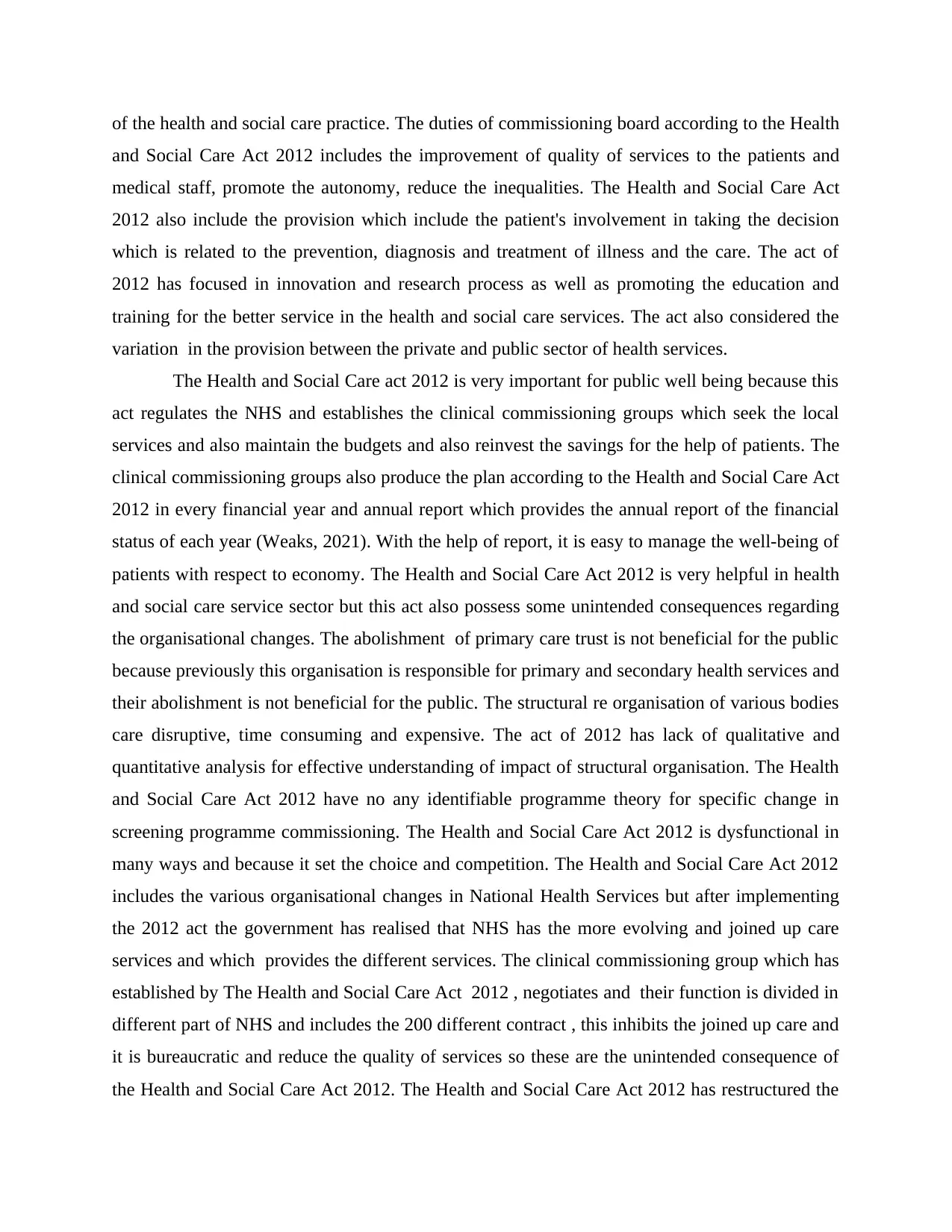
of the health and social care practice. The duties of commissioning board according to the Health
and Social Care Act 2012 includes the improvement of quality of services to the patients and
medical staff, promote the autonomy, reduce the inequalities. The Health and Social Care Act
2012 also include the provision which include the patient's involvement in taking the decision
which is related to the prevention, diagnosis and treatment of illness and the care. The act of
2012 has focused in innovation and research process as well as promoting the education and
training for the better service in the health and social care services. The act also considered the
variation in the provision between the private and public sector of health services.
The Health and Social Care act 2012 is very important for public well being because this
act regulates the NHS and establishes the clinical commissioning groups which seek the local
services and also maintain the budgets and also reinvest the savings for the help of patients. The
clinical commissioning groups also produce the plan according to the Health and Social Care Act
2012 in every financial year and annual report which provides the annual report of the financial
status of each year (Weaks, 2021). With the help of report, it is easy to manage the well-being of
patients with respect to economy. The Health and Social Care Act 2012 is very helpful in health
and social care service sector but this act also possess some unintended consequences regarding
the organisational changes. The abolishment of primary care trust is not beneficial for the public
because previously this organisation is responsible for primary and secondary health services and
their abolishment is not beneficial for the public. The structural re organisation of various bodies
care disruptive, time consuming and expensive. The act of 2012 has lack of qualitative and
quantitative analysis for effective understanding of impact of structural organisation. The Health
and Social Care Act 2012 have no any identifiable programme theory for specific change in
screening programme commissioning. The Health and Social Care Act 2012 is dysfunctional in
many ways and because it set the choice and competition. The Health and Social Care Act 2012
includes the various organisational changes in National Health Services but after implementing
the 2012 act the government has realised that NHS has the more evolving and joined up care
services and which provides the different services. The clinical commissioning group which has
established by The Health and Social Care Act 2012 , negotiates and their function is divided in
different part of NHS and includes the 200 different contract , this inhibits the joined up care and
it is bureaucratic and reduce the quality of services so these are the unintended consequence of
the Health and Social Care Act 2012. The Health and Social Care Act 2012 has restructured the
and Social Care Act 2012 includes the improvement of quality of services to the patients and
medical staff, promote the autonomy, reduce the inequalities. The Health and Social Care Act
2012 also include the provision which include the patient's involvement in taking the decision
which is related to the prevention, diagnosis and treatment of illness and the care. The act of
2012 has focused in innovation and research process as well as promoting the education and
training for the better service in the health and social care services. The act also considered the
variation in the provision between the private and public sector of health services.
The Health and Social Care act 2012 is very important for public well being because this
act regulates the NHS and establishes the clinical commissioning groups which seek the local
services and also maintain the budgets and also reinvest the savings for the help of patients. The
clinical commissioning groups also produce the plan according to the Health and Social Care Act
2012 in every financial year and annual report which provides the annual report of the financial
status of each year (Weaks, 2021). With the help of report, it is easy to manage the well-being of
patients with respect to economy. The Health and Social Care Act 2012 is very helpful in health
and social care service sector but this act also possess some unintended consequences regarding
the organisational changes. The abolishment of primary care trust is not beneficial for the public
because previously this organisation is responsible for primary and secondary health services and
their abolishment is not beneficial for the public. The structural re organisation of various bodies
care disruptive, time consuming and expensive. The act of 2012 has lack of qualitative and
quantitative analysis for effective understanding of impact of structural organisation. The Health
and Social Care Act 2012 have no any identifiable programme theory for specific change in
screening programme commissioning. The Health and Social Care Act 2012 is dysfunctional in
many ways and because it set the choice and competition. The Health and Social Care Act 2012
includes the various organisational changes in National Health Services but after implementing
the 2012 act the government has realised that NHS has the more evolving and joined up care
services and which provides the different services. The clinical commissioning group which has
established by The Health and Social Care Act 2012 , negotiates and their function is divided in
different part of NHS and includes the 200 different contract , this inhibits the joined up care and
it is bureaucratic and reduce the quality of services so these are the unintended consequence of
the Health and Social Care Act 2012. The Health and Social Care Act 2012 has restructured the
⊘ This is a preview!⊘
Do you want full access?
Subscribe today to unlock all pages.

Trusted by 1+ million students worldwide
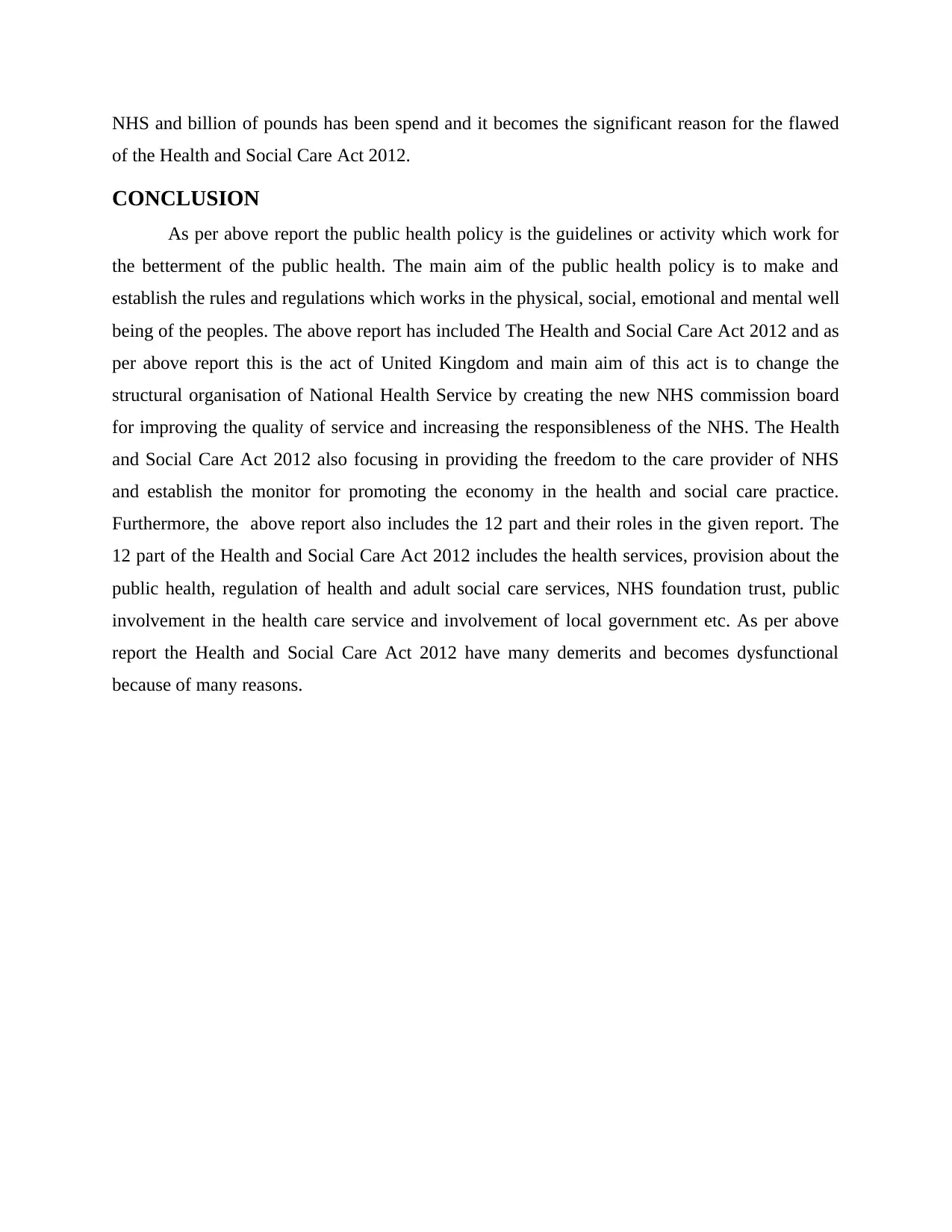
NHS and billion of pounds has been spend and it becomes the significant reason for the flawed
of the Health and Social Care Act 2012.
CONCLUSION
As per above report the public health policy is the guidelines or activity which work for
the betterment of the public health. The main aim of the public health policy is to make and
establish the rules and regulations which works in the physical, social, emotional and mental well
being of the peoples. The above report has included The Health and Social Care Act 2012 and as
per above report this is the act of United Kingdom and main aim of this act is to change the
structural organisation of National Health Service by creating the new NHS commission board
for improving the quality of service and increasing the responsibleness of the NHS. The Health
and Social Care Act 2012 also focusing in providing the freedom to the care provider of NHS
and establish the monitor for promoting the economy in the health and social care practice.
Furthermore, the above report also includes the 12 part and their roles in the given report. The
12 part of the Health and Social Care Act 2012 includes the health services, provision about the
public health, regulation of health and adult social care services, NHS foundation trust, public
involvement in the health care service and involvement of local government etc. As per above
report the Health and Social Care Act 2012 have many demerits and becomes dysfunctional
because of many reasons.
of the Health and Social Care Act 2012.
CONCLUSION
As per above report the public health policy is the guidelines or activity which work for
the betterment of the public health. The main aim of the public health policy is to make and
establish the rules and regulations which works in the physical, social, emotional and mental well
being of the peoples. The above report has included The Health and Social Care Act 2012 and as
per above report this is the act of United Kingdom and main aim of this act is to change the
structural organisation of National Health Service by creating the new NHS commission board
for improving the quality of service and increasing the responsibleness of the NHS. The Health
and Social Care Act 2012 also focusing in providing the freedom to the care provider of NHS
and establish the monitor for promoting the economy in the health and social care practice.
Furthermore, the above report also includes the 12 part and their roles in the given report. The
12 part of the Health and Social Care Act 2012 includes the health services, provision about the
public health, regulation of health and adult social care services, NHS foundation trust, public
involvement in the health care service and involvement of local government etc. As per above
report the Health and Social Care Act 2012 have many demerits and becomes dysfunctional
because of many reasons.
Paraphrase This Document
Need a fresh take? Get an instant paraphrase of this document with our AI Paraphraser
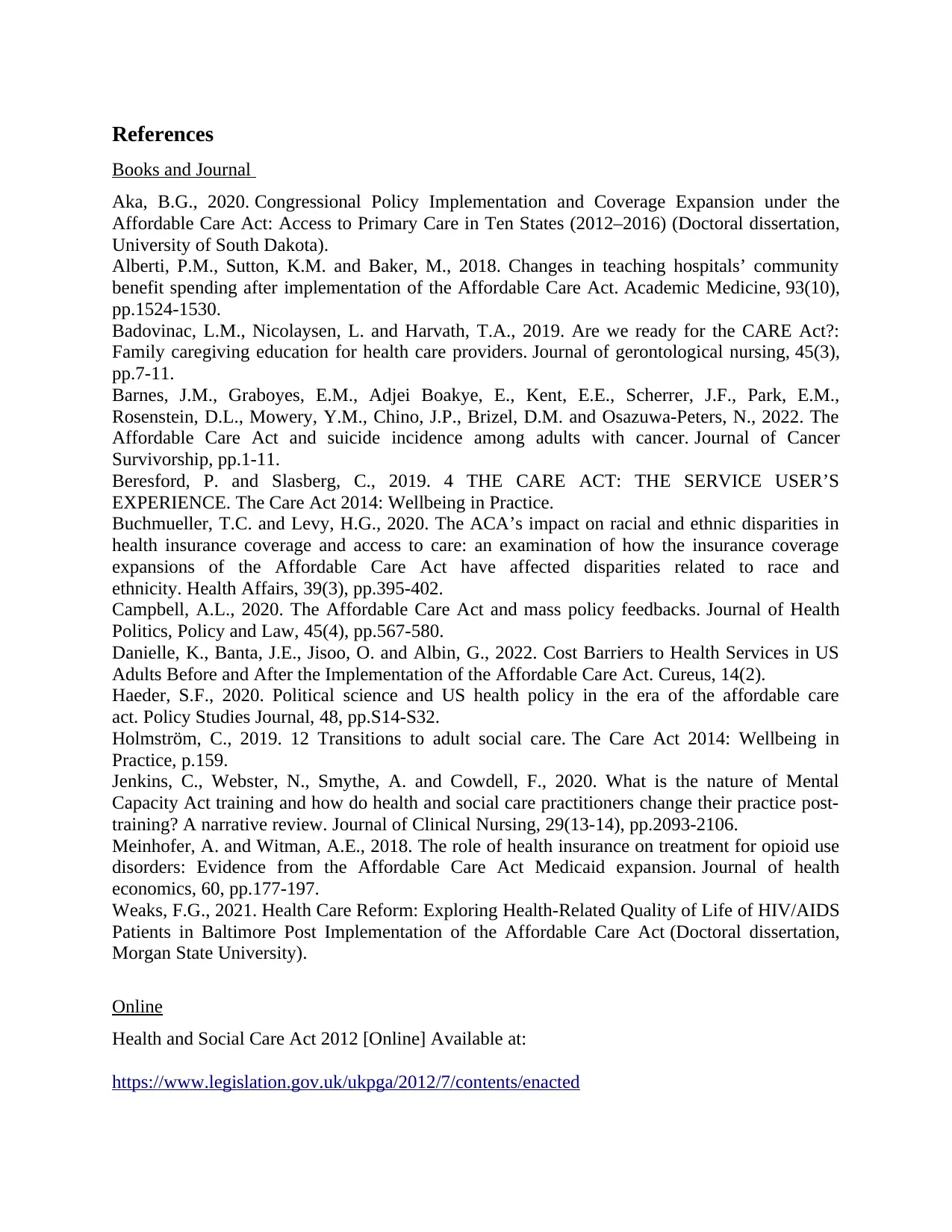
References
Books and Journal
Aka, B.G., 2020. Congressional Policy Implementation and Coverage Expansion under the
Affordable Care Act: Access to Primary Care in Ten States (2012–2016) (Doctoral dissertation,
University of South Dakota).
Alberti, P.M., Sutton, K.M. and Baker, M., 2018. Changes in teaching hospitals’ community
benefit spending after implementation of the Affordable Care Act. Academic Medicine, 93(10),
pp.1524-1530.
Badovinac, L.M., Nicolaysen, L. and Harvath, T.A., 2019. Are we ready for the CARE Act?:
Family caregiving education for health care providers. Journal of gerontological nursing, 45(3),
pp.7-11.
Barnes, J.M., Graboyes, E.M., Adjei Boakye, E., Kent, E.E., Scherrer, J.F., Park, E.M.,
Rosenstein, D.L., Mowery, Y.M., Chino, J.P., Brizel, D.M. and Osazuwa-Peters, N., 2022. The
Affordable Care Act and suicide incidence among adults with cancer. Journal of Cancer
Survivorship, pp.1-11.
Beresford, P. and Slasberg, C., 2019. 4 THE CARE ACT: THE SERVICE USER’S
EXPERIENCE. The Care Act 2014: Wellbeing in Practice.
Buchmueller, T.C. and Levy, H.G., 2020. The ACA’s impact on racial and ethnic disparities in
health insurance coverage and access to care: an examination of how the insurance coverage
expansions of the Affordable Care Act have affected disparities related to race and
ethnicity. Health Affairs, 39(3), pp.395-402.
Campbell, A.L., 2020. The Affordable Care Act and mass policy feedbacks. Journal of Health
Politics, Policy and Law, 45(4), pp.567-580.
Danielle, K., Banta, J.E., Jisoo, O. and Albin, G., 2022. Cost Barriers to Health Services in US
Adults Before and After the Implementation of the Affordable Care Act. Cureus, 14(2).
Haeder, S.F., 2020. Political science and US health policy in the era of the affordable care
act. Policy Studies Journal, 48, pp.S14-S32.
Holmström, C., 2019. 12 Transitions to adult social care. The Care Act 2014: Wellbeing in
Practice, p.159.
Jenkins, C., Webster, N., Smythe, A. and Cowdell, F., 2020. What is the nature of Mental
Capacity Act training and how do health and social care practitioners change their practice post‐
training? A narrative review. Journal of Clinical Nursing, 29(13-14), pp.2093-2106.
Meinhofer, A. and Witman, A.E., 2018. The role of health insurance on treatment for opioid use
disorders: Evidence from the Affordable Care Act Medicaid expansion. Journal of health
economics, 60, pp.177-197.
Weaks, F.G., 2021. Health Care Reform: Exploring Health-Related Quality of Life of HIV/AIDS
Patients in Baltimore Post Implementation of the Affordable Care Act (Doctoral dissertation,
Morgan State University).
Online
Health and Social Care Act 2012 [Online] Available at:
https://www.legislation.gov.uk/ukpga/2012/7/contents/enacted
Books and Journal
Aka, B.G., 2020. Congressional Policy Implementation and Coverage Expansion under the
Affordable Care Act: Access to Primary Care in Ten States (2012–2016) (Doctoral dissertation,
University of South Dakota).
Alberti, P.M., Sutton, K.M. and Baker, M., 2018. Changes in teaching hospitals’ community
benefit spending after implementation of the Affordable Care Act. Academic Medicine, 93(10),
pp.1524-1530.
Badovinac, L.M., Nicolaysen, L. and Harvath, T.A., 2019. Are we ready for the CARE Act?:
Family caregiving education for health care providers. Journal of gerontological nursing, 45(3),
pp.7-11.
Barnes, J.M., Graboyes, E.M., Adjei Boakye, E., Kent, E.E., Scherrer, J.F., Park, E.M.,
Rosenstein, D.L., Mowery, Y.M., Chino, J.P., Brizel, D.M. and Osazuwa-Peters, N., 2022. The
Affordable Care Act and suicide incidence among adults with cancer. Journal of Cancer
Survivorship, pp.1-11.
Beresford, P. and Slasberg, C., 2019. 4 THE CARE ACT: THE SERVICE USER’S
EXPERIENCE. The Care Act 2014: Wellbeing in Practice.
Buchmueller, T.C. and Levy, H.G., 2020. The ACA’s impact on racial and ethnic disparities in
health insurance coverage and access to care: an examination of how the insurance coverage
expansions of the Affordable Care Act have affected disparities related to race and
ethnicity. Health Affairs, 39(3), pp.395-402.
Campbell, A.L., 2020. The Affordable Care Act and mass policy feedbacks. Journal of Health
Politics, Policy and Law, 45(4), pp.567-580.
Danielle, K., Banta, J.E., Jisoo, O. and Albin, G., 2022. Cost Barriers to Health Services in US
Adults Before and After the Implementation of the Affordable Care Act. Cureus, 14(2).
Haeder, S.F., 2020. Political science and US health policy in the era of the affordable care
act. Policy Studies Journal, 48, pp.S14-S32.
Holmström, C., 2019. 12 Transitions to adult social care. The Care Act 2014: Wellbeing in
Practice, p.159.
Jenkins, C., Webster, N., Smythe, A. and Cowdell, F., 2020. What is the nature of Mental
Capacity Act training and how do health and social care practitioners change their practice post‐
training? A narrative review. Journal of Clinical Nursing, 29(13-14), pp.2093-2106.
Meinhofer, A. and Witman, A.E., 2018. The role of health insurance on treatment for opioid use
disorders: Evidence from the Affordable Care Act Medicaid expansion. Journal of health
economics, 60, pp.177-197.
Weaks, F.G., 2021. Health Care Reform: Exploring Health-Related Quality of Life of HIV/AIDS
Patients in Baltimore Post Implementation of the Affordable Care Act (Doctoral dissertation,
Morgan State University).
Online
Health and Social Care Act 2012 [Online] Available at:
https://www.legislation.gov.uk/ukpga/2012/7/contents/enacted
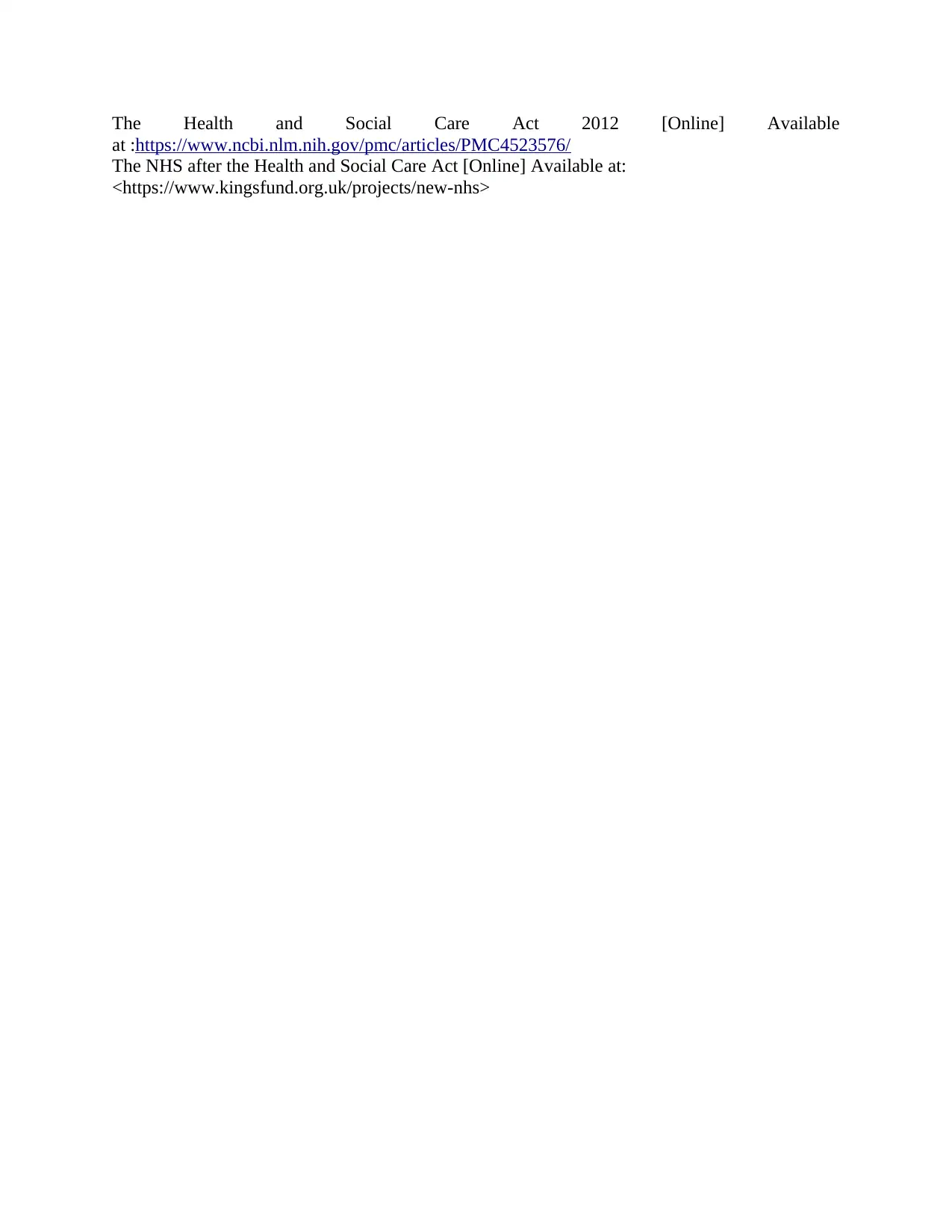
The Health and Social Care Act 2012 [Online] Available
at :https://www.ncbi.nlm.nih.gov/pmc/articles/PMC4523576/
The NHS after the Health and Social Care Act [Online] Available at:
<https://www.kingsfund.org.uk/projects/new-nhs>
at :https://www.ncbi.nlm.nih.gov/pmc/articles/PMC4523576/
The NHS after the Health and Social Care Act [Online] Available at:
<https://www.kingsfund.org.uk/projects/new-nhs>
⊘ This is a preview!⊘
Do you want full access?
Subscribe today to unlock all pages.

Trusted by 1+ million students worldwide
1 out of 12
Related Documents
Your All-in-One AI-Powered Toolkit for Academic Success.
+13062052269
info@desklib.com
Available 24*7 on WhatsApp / Email
![[object Object]](/_next/static/media/star-bottom.7253800d.svg)
Unlock your academic potential
Copyright © 2020–2025 A2Z Services. All Rights Reserved. Developed and managed by ZUCOL.




